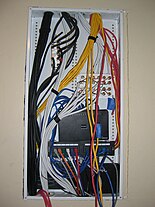Lighting control system
This article needs additional citations for verification. (June 2007) |
A lighting control system consists of a device or devices that control electric lighting in an automated manner. Lighting control systems are widely used on both indoor and outdoor lighting of commercial, industrial, and residential spaces. Lighting control systems serve to provide the right amount of light where and when it is needed. [1] This is accomplished using either stand-alone control systems, such as occupancy sensors, or network based solutions that incorporate intelligent communication between system inputs and outputs, usually with the use of one or more central computing devices.
Lighting control systems are often employed to satisfy building codes, or comply with green building and energy conservation programs.
Intelligent or networked lighting control systems typically include devices with embedded processors or industrial computer device, usually include one or more portable or mounted keypad or touchscreen console interfaces, and can include mobile phone operation. These control interfaces allow users the ability to remotely toggle (on-off) power to individual or groups of lights (and ceiling fans and other devices), operate dimmers, and pre-program space lighting levels.
Advantages
A major advantage of a lighting control system over conventional individual switching is the ability to control any light, group of lights, or all lights in a building from a single user interface device. Any light or device can be controlled from any location. This ability to control multiple light sources from a user device allows complex "light scenes" to be created. A room may have multiple scenes available, each one created for different activities in the room. A lighting scene can create dramatic changes in atmosphere, for a residence or the stage, by a simple button press. In landscape design, in addition to landscape lighting, fountain pumps, water spa heating, swimming pool covers, motorized gates, and outdoor fireplace ignition; can be remotely or automatically controlled.
Benefits
Other benefits include reduced energy consumption, and power costs through more efficient usage, longer bulb life from dimming, and reduced emission carbon footprints. Newer, wireless lighting control systems provide additional benefits including reduced installation costs and increased flexibility in where switches and sensors can be placed.[2]
Automated Control
Lighting control systems provide the ability to automatically adjust a lighting device's output based on:
- Chronological time (time of day)
- Astronomical time (sunrise/sunset)
- Occupancy using motion sensors
- Daylight availability using photocells
- Alarm conditions
- Program logic (combination of events)
Chronological time
Chronological time schedules incorporate specific times of the day, week, month, or year.
Astronomical time
Astronomical time schedules incorporate sunrise and sunset times, often used to switch outdoor lighting. Astronomical time scheduling requires that the location of the building be set. This is accomplished by inputting the latitude and longitude or by picking the nearest city in a given database giving the approximate location and corresponding astronomical times.
Occupancy
Space occupancy is primarily determined with motion sensors.
Daylight availability
Artificial lighting energy use can be reduced by automatically dimming and/or switching electric lights in response to the level of daylighting, a technology known as daylight harvesting.
Alarm conditions
Alarm conditions typically include inputs from other building systems such as the fire alarm or HVAC system, which may trigger an emergency 'all lights on' command for example.
Program logic
Program logic can tie all of the above elements together using constructs such as if-then-else statements and logical operators.
Theatrical Lighting Control
Architectural lighting control systems can integrate with a theater's on-off and dimmer controls, and are often used for house lights and stage lighting, and can include worklights, rehearsal lighting, and lobby lighting. Control stations can be placed in several locations in the building and range in complexity from single buttons that bring up preset options-looks, to in-wall or desktop LCD touchscreen consoles. Much of the technology is related to residential and commercial lighting control systems.
The benefit of architectural lighting control systems in the theater is the ability for theater staff to turn worklights and house lights on and off without having to use a lighting control console. Alternately, the light designer can control these same lights with light cues from the lighting control console so that, for instance, the transition from houselights being up before a show starts and the first light cue of the show is controlled by one system.
See also
- C-Bus (protocol)
- Digital Addressable Lighting Interface (DALI)
- Lutron
- DMX512
- Dynalite
- INSTEON
- KNX (standard)
- Lonworks
- Modbus
- MIDI
- Vantage Controls
- VSCP
- X10 (industry standard)
- Z-Wave
- Digital Lighting Systems, Inc
External links
Notes
- ^ DiLouie, Craig (2008). Lighting controls handbook. Lilburn, Ga. [u.a.]: Fairmont Press [u.a.] p. 239. ISBN 1-4200-6921-7.
- ^ "Lighting control saves money and makes sense" (PDF). Daintree Networks. Retrieved 2009-06-19.

